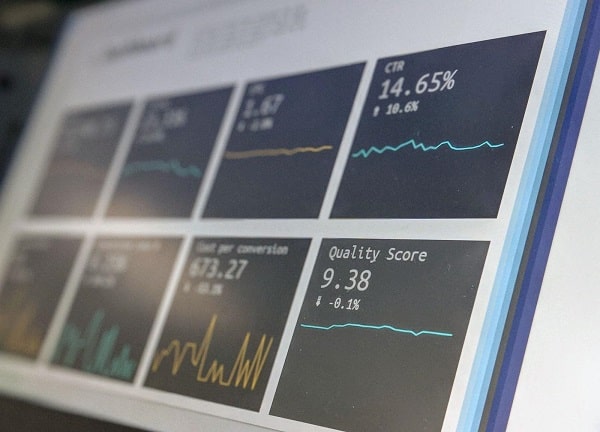[ad_1]
Predictive analytics is a branch of analytics that tries to use current data to understand what events could take place in the future. In making predictions, it relies on current findings, historical trends, AI, machine learning, and statistics. It also relies on foreign examples, especially in the field of cultural, economic, and sociological predictions. Read on to find out how you can benefit from using predictive content analysis in your business.
Predictive Content Analytics
Predictive content analytics takes its notions from predictive analysis in a more general meaning of the word. To do so, it relies on big data. Thousands of data points get collected over the Internet. They have been extracted from previous events, large-scale content releases, and new technology deployment.
Predictive content analysis is never done on a single piece of content. Quite on the contrary, it refers to a series or follows the life cycle of individual or grouped meta-elements. These elements are specific groupings of keywords, page elements, and supra elements. They are supposed to improve the visibility and content experience. They are followed on a larger scale, as they may be present in more than one piece of content that is to be posted online.
How To Use Predictive Content Analytics
Consider having a blog on green solutions, decarbonizing, and climate change mitigation. How you could use predictive content analytics is to:
- Take an analytical approach to your content,
- Group the content by the topic, the length, the relevance, the number of visits it got, the ranking on a search engine,
- Observe phenomena that you think may be contributing to the content’s popularity,
- Try to understand the patterns underlying the phenomena observed,
- Observe these patterns in a wider field. Pay attention to sociological behaviors, social trends, and other social phenomena you think may be relevant,
- Try to make assumptions about how the content would perform in the future. Think about what other kinds of content you should deploy. You should do this to ensure that positive phenomena (good ranking, a lot of visits, high interaction rate, low bounce rate, etc.) are repeated. Over time, you get the accumulative effect of adjustments you have made.
To make future predictions, it is necessary to understand the changes that took place in the past. In our imaginary blog about green solutions, we may observe a few articles. We can see that a series of articles with more images than average performed better than others. You may want to proceed with the analysis of elements in the content. You should also observe supra-elements linking this content to other web blogs, etc.
- We may proceed with analysis to discover that the keywords used were specific for younger age groups.
- They can also get used by people who have enough time and energy to spend hours a day on our blog.
- At the same time, a novel approach to guest-linking has increased the visits rate by 20%.
- Furthermore, changing the authority websites to those that rank higher on search engines has brought our own ranking score up.
- The nature of the media used in the articles was changed. Instead of stock photos, we use summative infographics that can also get shared on social media. They can create a funnel to our primary website.
Predictive Content Analytics in Practice
Now that we know the basics let’s consider small business owners and how they can best use predictive analytics. The business is a small content writing agency. They specialize in green tech and have a simple employee structure. One manager (and owner, and the CEO), one customer relations specialist, one editor, and seven content writers work there. They produce content for blogs, procedure pages, and YouTube scripts for channels dealing with green tech.
They are all young and capable, willing to learn, and are not set in their ways, so changing their approach to their work will not result in efficiency loss. Yet, the manager makes decisions with the intent of aiming their work in such a new direction. They should increase the usability and product value, both short and long-term. The manager uses predictive content analysis and findings from several related fields. They do that to improve the following aspects of their business:
- Target Audience Research,
- Identify New and Old Trends,
- Customer Care,
- Check out the Competition,
- Keep More Visitors,
- Improve Product-Making Process, and
- Tweak Your Business Model.
Target Audience Research
Target Audience Research is a crucial step in any predictive content analysis. Knowing who your audience is now can help you understand where the audience may be moving to next. Expanding your business in that direction beforehand will mean you’ve anticipated the change. Now, you have made the right moves to help the change rather than adjust to it.

For example, YouTube introduced double ads and increased their length from 5 seconds to 7. Many YouTubers and portions of their audience started moving to Patreon. They also started using the best cheap essay writing service to speed up their scriptwriting process. This is of crucial importance for your business since YouTube scripts bring in a part of your income.
Changing the way you advertise will make sure you are ready and trending if a large-scale migration from YouTube takes place. You can also include specialized articles on each of these platforms on your own blog and adjust the links in your Instagram bio. This may or may not happen. In both cases, you have still expanded your outreach, the scope of your services and have addressed one more segment of the market.
For example, understanding the buying behavior of your audience can help you sell more. Walmart used behavior analysis combined with predictive analytics to come up with a model of how their customers react and shop in certain circumstances. They have used these findings to tweak their prices and items on sale to increase revenue.
You can use the basic stats of your customers to tweak their experience on your website, their interaction with the ads, and the types of content you deliver. If you run a content marketing agency, you can use this knowledge to expand or focus the topics you cover, the ways that your customers can reach you, or even the customer care and support.
Identify New and Old Trends
When identifying old and new trends, it is important to stay very general. Saying that 14-year-old boys prefer to read shorter articles does not help much. But noticing that people in the 15-30 age group tend to use shorter words and no punctuation can influence product development.

This trend rids of anything not essential for communication. It aims to bridge the emotional void that there is in written communication. This finding can then lead you to assume that YT titles and captions with no punctuation are more likely to get trending. You hold a meeting with your writers and the editor, and voilà! Your content trends are better than before.
Back in the old days, doctors had to rely on their experience only to understand the trends that were seasonal in nature. Today, Stevens Institute of Technology uses predictive analytics to understand the seasonal fluctuation in flu numbers, heart attacks, and hypertension, and the hospitals are stocked accordingly.
You can follow the trends to better understand how your audience changes. You will notice that the interests and expectations of your returning customers change over time. You will also notice that the approach that worked for one generation does not work anymore, just a year or two later. You can use predictive analysis to tweak your approach and address novel trends.
Customer Care
On this, you may decide to use predictive analytics to assume what kind of issues your customers may have. Then you can use these findings to make protocols that would include many actions stemming from a single email an angry client may send you. A simple email should be enough for you to identify, analyze, and solve the problem. You can also propose downloading a freebie, watching a YouTube tutorial on how to use the content you create, etc. The customer leaves satisfied. You’ve turned their minimal input into a satisfying experience.
Amazon, one of the biggest retailers in the world, uses predictive analytics when employing and scheduling its customer care staff. Predictive analytics is used to estimate a range of phone calls, emails, and chat requests for each separate country Amazon works in. This is one of the reasons there is a very short wait time when asking Amazon for support.
Customer care is a vital part of any business. Using predictive analytics, you can tweak your approach to the customers and address any emerging trends. You can also use these findings in your email campaigns to renew the interest of your old customers and present new products to this segment of your market cap.

Check Out the Competition
Sometimes, researching your competitors and seeing how they handle daily tasks can give you valuable information. Let’s assume your competitors found ways to reduce the steps in their conversion funnels. You should do so as well, especially if you notice they’ve been particularly busy. If you notice new social network trends, use them as well.

For example, you can read reviews of your competitors. Reading essay writing service reviews for a few minutes a day will let you know how the competition is doing. It will also make you understand better what the customers are asking for so that you can increase your own rating on similar websites.
SEMrush, for example, uses predictive analytics to analyze the market and inform their clients on the assumed future moves of their competition. In doing so, they collect publicly available data that they work with to predict future moves in your market niche. They enable looking into traffic share, marketing mix, and geopolitical information of their visits (think: developing countries).
Your business can benefit greatly by you checking out the competition regularly. One of the emerging trends in recent years has been diversifying income streams on the business level. If you are aware of the steps your competitors make today, you can tweak yours tomorrow and still stay one step ahead. Your competitors implement a new credit line for those solar panels they sell? You can too. Stay on top of the game.
Retain More Visitors
If you conduct your predictive content analytics the right way, you will be able to use your content to drive even more traffic to your website and your business. Keyword analysis shows that people tend to increase the number of questions they type into search engines, instead of key phrases. Following past trends, it is safe to assume that this will continue.

But what does it have to do with your content writing? Well, including questions in your text might be the answer. You will rank higher and may even appear on Google PAA snippets. Furthermore, including an FAQ section in your blog posts will act as evergreen content and keep generating organic traffic for years to come.
Etsy implemented a new model of shipping, always included in their listings, several years back. Before they decided on the bold move of informing all their sellers to include shipping in their prices, they did customer behavior analysis and have used predictive analytics to see whether the sales would increase. They did, so free shipping was introduced.
So, you can use predictive analytics to retain more visitors. You can do that by following the trends you see in the market and tweaking your email campaigns and making changes to the website. The best place to start is to add blog posts and tweak your content so it keeps customers on the site.
Improve Product-Making Process
Your predictive content analysis may also pinpoint some new developments in what people consider authority sources. What used to be the NYT is now the Guardian, for better or worse. Being able to spot these changes will increase your relevance in the eyes of Google and make sure you rank higher. Analyzing linguistic trends will likewise result in more optimized content and a lower bounce rate.
The Japanese inventory management system is the best example of predictive analytics. Toyota, General Motors, and Ford Motor Company all use this proven system. Under this management system, a company keeps as little inventory as possible since these are frozen funds. Predictive analytics is used to understand future patterns, and the product-making process is tweaked to ensure products are made when they are needed.
To best utilize predictive analytics to tweak your product-making process, consider investigating the new and emerging tastes of your customers. Floral perfumes, for example, are on the rise, and being able to offer a line before the need has skyrocketed can earn your business a lot of money. In the writing niche, YouTube scripts are also increasing in popularity, so offering this type of content will attract more customers.

Related Content
Final Considerations
Being able to recognize novel trends and streams in any niche is of paramount importance for the product and service development of today. Doing so for a longer period of time should result in your being able to expect future trends.
By using predictive (content) analytics, you should be able to do research on your target audience, identify new and old trends in your niche, improve customer care, analyze your competition better, increase your conversion rate and improve product-making. Always remember that successful businesses help change and do not adapt to them once they’re full-scaled.

Written by our guest writer Erica Sunarjo
Erica tries hard to streamline her work. Only this way can she make herself even more efficient and in line with the growing demands of her work. She contributes to Online Writers Rating, as she believes that this kind of feedback benefits everybody.
[ad_2]
Source link






